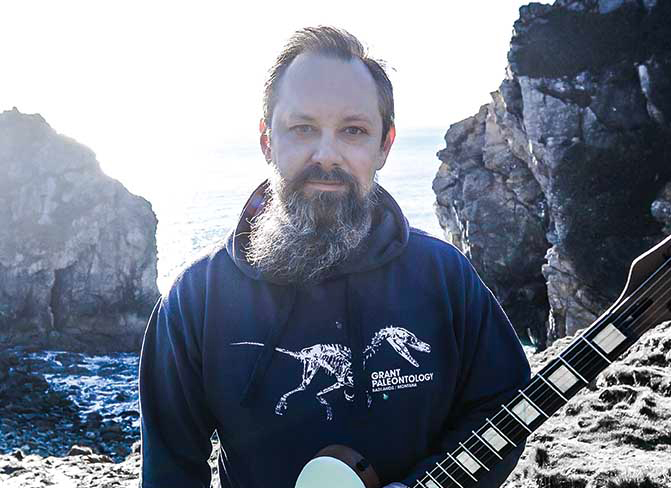5 ways to play guitar like Greg Howe
These advanced exercises in shred guitar will take you through the Shrapnel alum’s sweeping and tapping style, and offer a grounding in his quicksilver jazz-fusion improv concepts

Throughout his career Greg Howe has donned many hats, starting in 1988 with his Shrapnel Records self-titled debut which showcased his technical command and creativity.
To date Greg has released 10 more solo albums which have progressively evolved into the jazz and fusion genre. Greg has worked extensively as a session guitarist too, having toured and performed with some of the biggest names in pop: Michael Jackson, Christina Aguilera, Rhianna, ’N Sync and Justin Timberlake to name but a few.
We have five examples that offer an insight into Greg’s style, from techniques like sweeping and tapping to some jazz-fusion improvisational concepts.
For our first example, we start with a moderate speed lick based in A Dorian (A-B-C-D-E-F#-G). Rather than playing a Dorian scale shape, Greg will often prefer four-note arpeggios from the key. In A Dorian the available arpeggios are: Am7, Bm7, Cmaj7, D7, Em7, F#m7b5 and Gmaj7.
You can experiment by playing each of these sounds over the Am7 backing track and you will hear how each one produces a unique sound, although you remain within the ‘Dorian’ framework. This approach is called arpeggio superimposition. In our example the lick is based in the Cmaj7 arpeggio, which gives us a Minor 9 flavour over the Am7 chord.
Sometimes however, Howe will need to simply burn through the Dorian mode with fluidity. Example 2 shows a tapping approach Greg uses which has two hammer-ons with the fretting hand and a tap with the picking hand. This creates an even, synth-like tone distinctly different to the typical one-handed legato approach.
For our third example, we combine sweeping, legato and tapping to create some wide octave sounds. The first four notes are played with a smooth, flowing downstroke across the strings, then we remain on the first string and pick out notes from C Ionian (C-D-E-F-G-A-B) using legato and some tapping. You can apply this technique to any arpeggio or scale.
Example 4 is a scale sequence lick using tapped notes to smoothly descend through the E Blues scale three notes at a time. This is a useful technique for injecting a burst of speed within a solo. The notes fly by, but finger speed is relatively unimportant once you have developed some coordination.
Our final example is another superimposed arpeggio. This time Bm7 over an Em7 chord, which you can think of as ‘minor 7 up a 5th’ for easy transposition to other keys. This lick also uses chromatic passing notes which add tension and release. Learn the licks slowly and accurately before building up to speed and then practice over the backing tracks.
Get the tone
Amp settings: Gain 7, Bass 7, Middle 7, Treble 6, Reverb 3
Greg plays a signature guitar by Kiesel, a Carl Martin Lick Box pedal with Boost, Crunch and Distortion modes, into DV Mark ‘Maragold’ amps.
Greg is known for very rich overdriven tones so you want smooth, sophisticated drive not scratchy square-wave distortion. Use your bridge pickup but tame any over-brightness, and add ambient reverb or delay.
Example 1
Start with your second finger and pull off to the first finger. Use all four fingers to descend the Cmaj7 arpeggio. Next shift down to the 5th fret to continue the Cmaj7 in a different position. Focus on keeping the notes even in length and volume for a smooth effect.
Example 2
Hammer-on using the first and second fingers of your fretting hand, then tap with a fretting-hand finger of your choice to complete the three-notes-per-string shape. Use the underside of your fretting fingers to mute the treble strings and the side of your palm to mute the bass strings to keep the lick noise free.
Example 3
Sweep across the top four strings while holding down only one finger at a time for note separation. Next hammer-on with second and fourth fingers before tapping the 17th fret. Finally pull-off through the scale and tap on to the arpeggio notes with your fretting hand. Repeat the lick while changing the tapped note each time.
Example 4
Play the opening bend at the 15th-fret with your fretting-hand’s third finger, then tap down onto the 17th fret with your second picking-hand finger. Start by playing just the tapped notes which descend the scale, and land on each downbeat. Damp any unwanted strings with either or both hands.E
Example 5
Start with a hammer-on from first to fourth fingers, then ascend the Bm7 arpeggio before sliding from 17th to 19th fret with the fourth finger. Now descend the arpeggio half an octave, and finish with the chromatic jazzy line, keeping the notes even. The final F# note’s vibrato is performed by sliding either side of the 16th fret.
Get The Pick Newsletter
All the latest guitar news, interviews, lessons, reviews, deals and more, direct to your inbox!
Charlie Griffiths plays guitar in acclaimed prog-metal outfit Haken, and has a wealth of experience handling corporate and session gigs for genres as diverse as rock, heavy metal and pop. He has been a regular contributor to Total Guitar, Guitar Techniques, and Guitar World for over a decade, and released his debut solo album Tiktaalika in 2022.
"Upgrading from your entry-level acoustic opens the door to an entirely new world of tonewoods, body shapes, and brands": 6 signs it's time to upgrade from your first acoustic guitar
"I'm past my prime": 5 common excuses for not learning the guitar – and 5 body and mind-boosting reasons you should








![Joe Bonamassa [left] wears a deep blue suit and polka-dotted shirt and plays his green refin Strat; the late Irish blues legend Rory Gallagher [right] screams and inflicts some punishment on his heavily worn number one Stratocaster.](https://cdn.mos.cms.futurecdn.net/cw28h7UBcTVfTLs7p7eiLe.jpg)


